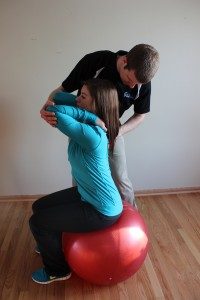What is Functional Chiropratic?

What exactly is “functional” chiropractic? What do you do differently than other chiropractors? I have gotten variations of these questions a lot lately, so it’s time I offer my explanation. The simple answer is, “Functional chiropractic focuses on movement and function of the body as a whole. I will have you perform certain movement tests to assess and evaluate your movement- your muscle function and your joint motion. Then we combine adjustments, soft tissue treatments, and exercises to get you back to the activities you enjoy and help you stay healthy.” That’s pretty over-simplified, so let’s take a look at what this means.
 With advances in diagnostic imaging and new scientific research, our understanding of how the spine functions has changed dramatically. This has led to a paradigm shift in chiropractic to a dynamic (or functional, movement-based) model for treatment. With new research using MRI (1) we have a better understanding that an adjustment or joint manipulation is restoring proper joint motion for improved function. We have also learned that joint manipulation does not only affect the function of one single vertebra (bone in the spine), but that it has a regional and likely global effect (2, 3, 4). So while posture is still just as important as your mother told you, it’s less about alignment and more about optimal joint and muscle function.
With advances in diagnostic imaging and new scientific research, our understanding of how the spine functions has changed dramatically. This has led to a paradigm shift in chiropractic to a dynamic (or functional, movement-based) model for treatment. With new research using MRI (1) we have a better understanding that an adjustment or joint manipulation is restoring proper joint motion for improved function. We have also learned that joint manipulation does not only affect the function of one single vertebra (bone in the spine), but that it has a regional and likely global effect (2, 3, 4). So while posture is still just as important as your mother told you, it’s less about alignment and more about optimal joint and muscle function.
Very rarely do we have optimal joint and muscle function at all times. As our daily activities and stresses take a toll on our bodies, it changes the way our muscles and joints function. This is where functional chiropractic becomes important, with a cutting-edge understanding of how the muscles and joints function as a whole and how interconnected our muscles and joints are through connective tissues (5). Many chiropractors utilized a much wider scope of treatment than only joint manipulation. For example, as a board-certified chiropractic physician, I understand that joint manipulation alone is not the most effective treatment approach for muscle and joint pain. This is why I have sought out additional training in functional movement testing, muscle release techniques such as Graston Technique® and Active Release Technique® to better address muscle function, Dynamic Neuromuscular Stabilization for a global approach to muscle and joint function, and McKenzie Method to better educate patients and help them treat their own neck and back pain, especially conservative treatment of disc bulges and herniations. These additional treatment strategies incorporate some of the best of chiropractic and physical therapy to provide the patient with a comprehensive, conservative approach to their health care.
With this wide range of treatment skills available, a doctor of chiropractic is able to address the entire musculoskeletal system and no longer just the spine. This functional approach to treatment is effective for a wide range of muscle and joint pain, such as frozen shoulders, rotator cuff injuries, elbow pain, carpal tunnel, hip pain, knee pain, tendinitis/tendinosis, plantar fasciitis, and many more, as well as neck and back pain.
If you are interested in the services we provide or how we may be able to serve you and help you reach your health goals, I offer a free, no-obligation 15-minute consultation. Please give us a call at (262) 289-9220 or schedule here.
1. Cramer GD, Gregerson DM, Knudsen JT, et al. The effects of side-posture positioning and spinal adjusting on the lumbar Z joints: a randomized controlled trial with sixty-four subjects. Spine, 2002;27(22):2459-
2. Ross JK, Bereznick DE, McGill SM. Determining Cavitation Location During Lumbar and Thoracic Spinal Manipulation. Spine, 2004;29:1452–1457
3. Lehman GJ, McGill SM. The influence of a chiropractic manipulation on lumbar kinematics and electromyography during simple and complex tasks: a case study. J Manipulative Physiol Ther, 1999;22:576-81.
4. Lehman GJ, McGill SM. Spinal manipulation causes variable spine kinematic and trunk muscle electromyographic responses. Clin Biomech, 2001;16:293-9.
5. Myers, Thomas. Anatomy Trains: Myofascial Meridians for Manual and Movement Therapists. New York: Elsevier 2009.
 262-373-9168
262-373-9168



